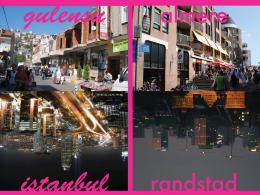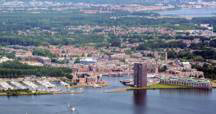Can designers form a symbiosis between formality and informality; cease to control, and facilitate uncertainty? Responsivity is the socio-spatial quality, mediating between the formal and the informal. It can be measured by the adaptability of space to user’s dynamic needs. Visions, negotiations and adaptations, urban regulations and flexibility of urban form influence the responsivity.
Organized by INTI and TU Delft, The Responsive City Masterclass visits formal and informal new towns, investigates hidden bottom up visions of the residents, and integrates them to an interactive city game.
Masterclass I: Almere 29 September - 3 October 2008
Masterclass II: Gulensu, Istanbul 27 - 31 October 2008
Final presentation masterclass I October, 3rd Corrosia Markt 1 Almere Haven.
Masterclasses were run by ir. Ekim Tan, prof. Arnold Reindorp and prof. Juval Portugali.
Planning is a messy, time and energy-consuming business of trial, error and failure, success is not a certainty and even when the result is successful, it is often a surprise, not what was actually being sought.
Jane Jacobs
20th century idea of controlling or predicting urban complexities leaves its place to the ’responsive’ approach. Thus, the traditional role of the planner/designer changes in the complexity, uncertainty and irregularity of the 21st century city. The ’visionary’ idea makes only sense by the filter of micro-level adaptations. and only through the ’negotiations’ of micro-level realities the complexity of an urban system can be achieved. ’Responsivity’ replaces determinism.
The responsive city
The responsive city-workshop is the second in the ’self organization and new towns’ series of the International New Town Institute [INTI]. It consists of two master-classes in Almere-the Netherlands and Maltepe-Istanbul.
’Responsivity’ is the quality indicating the adaptability of a physical surrounding to user?s dynamic needs. It can be studied by revealing visionary, adaptive, and negotitative mechanisms influential on the emergence of urban physical space. Actors [agents] of a given urban process activate these mechanisms. Therefore behaviors of agents [individual, collective, bottom up, top down, responsive or institutional] become main interest of such a research and, mapping the visionary, adaptive and negotiative component of an urban complexity requires both a local on-site [field interviews] as well as a global analysis [gis mapping].
Cases
This research will be conducted in almere haven subcenter of the new town of almere - in the Netherlands and the informal settlement of Gulensu-Maltepe in Istanbul. These at first glance contrasting samples will help to scrutinize possible visionary, adaptive and negotiative roles diverse agents play in different design regimes. This confrontation of planned and emerged new towns gives the unique opportunity to compare and elaborate on possible roles of 21st century planner/designer. Both samples emerged/were planned during the mid 70s, having the same life span of 30 years. Properties such as size, age, distance from centralities are fixed for the precision of comparisons.
Gulensu-Maltepe is an informal settlement of Istanbul, is a characteristic example of ’free agency’. this settlement emerged from urgent shelter need of its inhabitants migrated from the rural into metropolitan areas. while the first settlers date back to the beginning of seventies, most of the growth took place between 1978 and 1980. the population of the settlement is estimated to be 25.000 [this number is based on the information provided by the local government, ’Muhtarlik’. It differs greatly from the official number released by the central government, which is almost half] It is located on a hill in the Asian part of the city with a view on the princes islands on Bosporus. It is 25km far from the centre of Istanbul, Taksim.
Almere Haven is typical for ’controlled agency’. Almere’s emergence, as a new town is based on mainly controlling the growth of the capital city of the Netherlands, Amsterdam. The central planning office, Rijksdienst voor de IJsselmeerpolders [RIJP], has been the main player in the emergence of this new town. Werven is the oldest neighbourhood of Almere, the building period dates back to 1977 and 1980. First inhabitants of the quarter came mainly from Amsterdam. It is located 25 km away from the downtown Amsterdam, and 6 km from the new centre of Almere. Almere Haven counts 22.565 people. The centre, as the name suggests, is organized around a harbour.
Thanks to:







